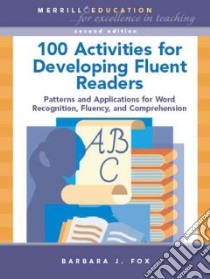100 Activities for Developing Fluent Readers - 9780131561328
Un libro in lingua di Fox Barbara J. edito da Prentice Hall, 2007
- € 47.90
- Il prezzo è variabile in funzione del cambio della valuta d’origine
Describes how phonemic awareness, phonics and vocabulary contribute to fluency, and how automatic word recognition and fluency contribute to comprehension-Gives the reader a clear conceptual framework for implementing classroom practices.
Offers a plethora of easy-to-implement teaching appropriate for children in classrooms from kindergarten through fifth grade-The wide range of activities makes this book a useful resource for preservice teachers who do not know the grade they will teach and inservice teachers in graduate courses or in the classroom, as well as for coaches (or mentors) in the elementary school.
Boxed features describing best practices for teaching (1) the major components of reading, (2) English language learners and (3) struggling readers-Best practices give the reader guidance for improving classroom practices specifically tailored to teaching each component, English learners and struggling readers.
Informal assessments in each chapter-Suggestions for informal assessments provide classroom-appropriate methods that can be used for formative and summative evaluations of student learning.
Activities give the reader advice on grouping, provide a list of material, and include step-by-step directions-Clear, reader friendly explanations give the reader all the information needed to implement activities, thereby making it easier for the reader to use activities in the classroom.
Informazioni bibliografiche
- Titolo del Libro in lingua: 100 Activities for Developing Fluent Readers
- Sottotitolo: Patterns and Applications for Word Recognition, Fluency, and Comprehension
- Lingua: English
- Autore: Fox Barbara J.
- Editore: Prentice Hall
- Collana: Prentice Hall (Paperback)
- Data di Pubblicazione: 15 Giugno '07
- Genere: EDUCATION
- Argomenti : Word recognition Reading Phonetic method Reading (Elementary
- Pagine: 156
- Dimensioni mm: 273 x 203 x 12
- ISBN-10: 0131561324
- EAN-13: 9780131561328


